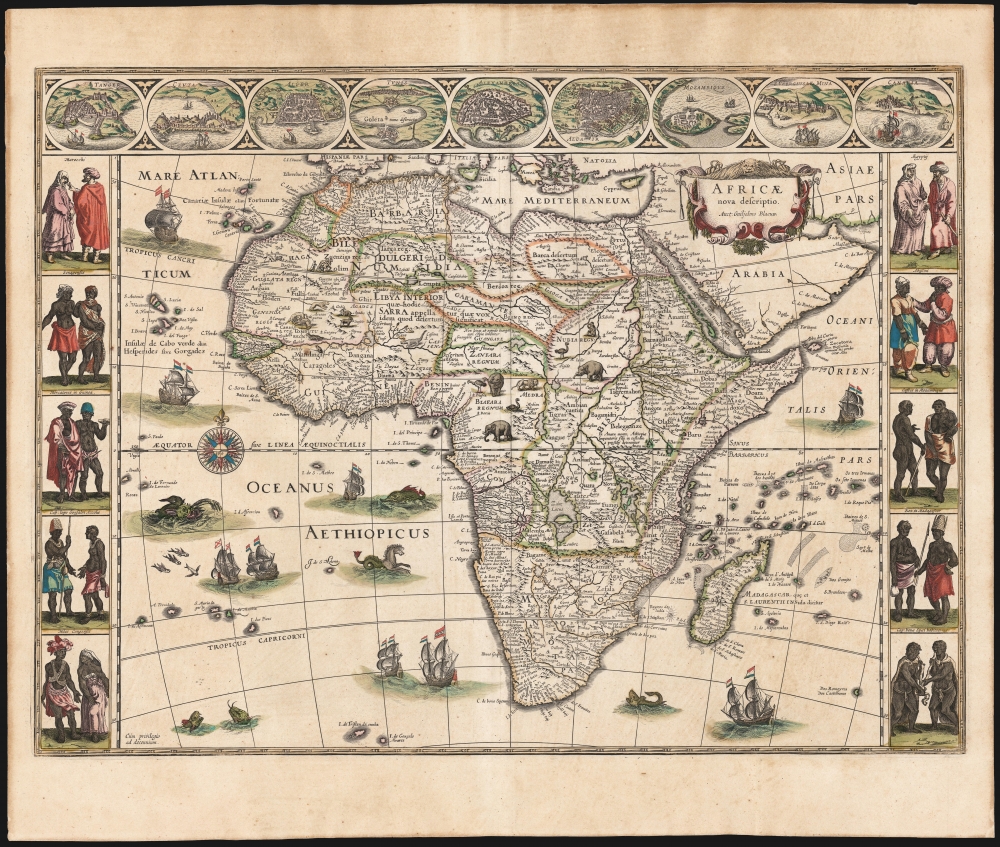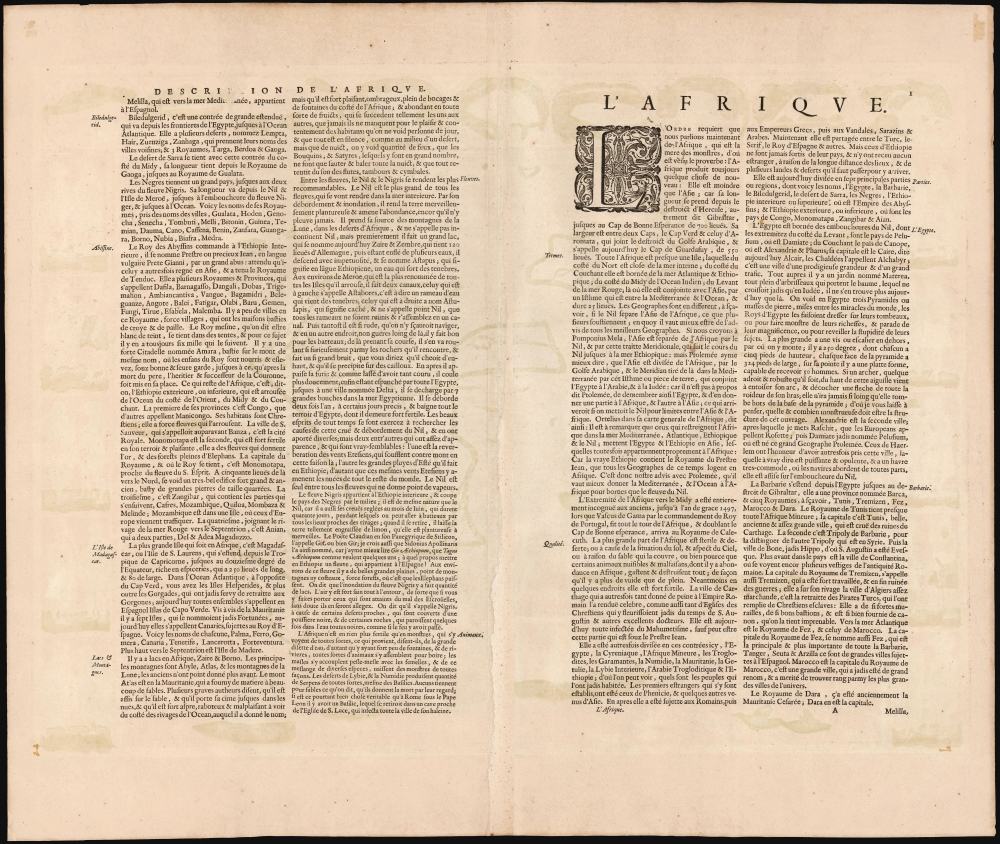
This item below is out of stock, but another example (left) is available. To view the available item, click "Details."
Details
1630 / 1640 Blaeu Map of Africa: Scarce Second State, Superb Original Color
1630 (undated) $5,000.00
1647 Blaeu Map of Africa: A Superb Original Color Example
Africae-blaeu-1647-2
Title
1647 (undated) 16.25 x 22 in (41.275 x 55.88 cm) 1 : 25000000
Description
The Map
Blaeu's map is essentially a reduced version of his own 1608 wall map of the continent, which would provide the standard for virtually all mapping of Africa until the late 17th century. Blaeu's atlas map here, first engraved in 1617, is particularly prized for its clarity and sharpness, presenting copious detail (and its many decorative features) without sacrificing legibility. The coastline is rich in toponomy and the overall shape of the continent is remarkably accurate. Points within the continent, nonetheless, reveal the European ignorance of Africa's interior that would maintain until well into the 19th century. The Nile, for example, is illustrated with its sources in the lakes of Zaire and Zaflan, an assumption inherited from no less venerable an authority than the 2nd century Alexandrian Claudius Ptolemy. The equally fictitious Lake Sachaf, derived from Laurent Fries' 1522 geography, appears in southern Africa feeding the Zambere River, flowing to the Rio de Spirito Santo. The Cuama River is shown north of the Rio de Spirito Santo, but unlike earlier maps - including Blaeu's own wall map - the Cuama is given its own source, instead of sharing a source at Lake Sachaf. The Niger River is shown running, essentially, in the wrong direction: it is shown emptying into the Senegal river, after having flowed from an imagined Lake Niger in the general vicinity of what is now the Central African Republic. (The detailed mapping of the Niger River would not be complete until the 1890s.)The Cities
Along the top border of the map are nine medallions containing views of African cities of importance. Tanger (Tangiers) in northwestern Morocco, the city of Ceuta in northern Africa (now Spanish, then Portuguese), Alger (Algiers), Tunis, Alexandria, and Cairo. All six of these are coastal cities of North Africa and were from classical times within the European orbit. The remaining three cities represented - Mozambique, St. Georges de la Mina, and Canaria (Tenerife, in the Canary Islands) all reflect the growing reach of Europe during the age of discovery. All were important ports for the circumnavigation of the African continent, with Portuguese forts established by the time this map was published. Of these, the castle de la Mina is notorious as a staging area in the transatlantic slave trade. Most of the views show remote fortress towns, in contrast to the sprawling ancient cities of Alexandria and Cairo. Blaeu's source for these views was the Braun and Hogenberg Civitates Orbis Terrarum, the first printed 'city atlas' or collection of city plans and views from all over the explored world.Cartes à Figures
During the Dutch Golden Age of mapmaking in the first half of the 17th century, maps' decorative elements reached a height that would be alluded to but seldom matched in later periods of cartography. 'Cartes à Figures' (maps with human figures in decorative borders) were at the pinnacle of Dutch decorative cartography. These decorations served a function: atlas maps of the day were not meant to guide the prospective traveler but were intended to inform the literate layperson what the rest of the world was like. The upper decorative border of this map with its city plans and views communicates how the denizens of Africa live. The border decoration on the left and right are meant to show what the denizens of Africa looked and dressed like. Typically, these pair a man and a woman for each region. Blaeu's Africa features Moroccans, Egyptians, Senegalese, Abyssinians, Guinean merchants, Mozambicans, a couple from Cape Lopez in Gabon, a royal couple from Madagascar, a Congolese soldier and his wife, and a fearsome portrayal of the denizens of the Cape of Good Hope.Cartes à figures were deluxe productions and seldom produced for narrow, regional maps save in scarce separate issues, and not all mapmakers included them in regular atlases. Willem Blaeu's world and continental maps are considered classics of the form.
Publication History and Census
This map was first engraved in 1617 and offered as a separate issue. Starting in 1630, the map was added to Blaeu's atlases in which it would remain until the end of the company's existence in 1672. No printings of the map later than this are known, indicating that the copperplate was among those destroyed in the great fire that finished the company. The third state of this map (of which this is an example) began to appear in Blaeu's Atlas Novusin about 1647; the verso typography here is consistent with examples found in the 1645-1650 French edition of Blaeu's Le Théâtre du Monde ou Nouvel Atlas. According to Betz this third state of the map was introduced in 1647, the date we are applying here. The map and its atlas are well represented in institutional collections and the map appears on the market. Examples with original color of this quality and condition, however, have grown scarce.CartographerS
Willem Janszoon Blaeu (1571 - October 18, 1638), also known as Guillaume Blaeu and Guiljelmus Janssonius Caesius, was a Dutch cartographer, globemaker, and astronomer active in Amsterdam during the late 16th and early 17th centuries. Blaeu was born 'Willem Janszoon' in Alkmaar, North Holland to a prosperous herring packing and trading family of Dutch Reformist faith. As a young man, he was sent to Amsterdam to apprentice in the family business, but he found the herring trade dull and instead worked for his cousin 'Hooft' as a carpenter and clerk. In 1595, he traveled to the small Swedish island of Hven to study astronomy under the Danish Enlightenment polymath Tycho Brahe. For six months he studied astronomy, cartography, instrument making, globe making, and geodesy. He returned to Alkmaar in 1596 to marry and for the birth of his first son, Johannes (Joan) Blaeu (1596 – 1673). Shortly thereafter, in 1598 or 1599, he relocated his family to Amsterdam where he founded the a firm as globe and instrument makers. Many of his earliest imprints, from roughly form 1599 - 1633, bear the imprint 'Guiljelmus Janssonius Caesius' or simply 'G: Jansonius'. In 1613, Johannes Janssonius, also a mapmaker, married Elizabeth Hondius, the daughter of Willem's primary competitor Jodocus Hondius the Elder, and moved to the same neighborhood. This led to considerable confusion and may have spurred Willam Janszoon to adopt the 'Blaeu' patronym. All maps after 1633 bear the Guiljelmus Blaeu imprint. Around this time, he also began issuing separate issue nautical charts and wall maps – which as we see from Vermeer's paintings were popular with Dutch merchants as decorative items – and invented the Dutch Printing Press. As a non-Calvinist Blaeu was a persona non grata to the ruling elite and so he partnered with Hessel Gerritsz to develop his business. In 1619, Blaeu arranged for Gerritsz to be appointed official cartographer to the VOC, an extremely lucrative position that that, in the slightly more liberal environment of the 1630s, he managed to see passed to his eldest son, Johannes. In 1633, he was also appointed official cartographer of the Dutch Republic. Blaeu's most significant work is his 1635 publication of the Theatrum orbis terrarum, sive, Atlas Novus, one of the greatest atlases of all time. He died three years later, in 1638, passing the Blaeu firm on to his two sons, Cornelius (1616 - 1648) and Johannes Blaeu (September 23, 1596 - December 21, 1673). Under his sons, the firm continued to prosper until the 1672 Great Fire of Amsterdam destroyed their offices and most of their printing plates. Willem's most enduring legacy was most likely the VOC contract, which ultimately passed to Johannes' son, Johannes II, who held the position until 1617. As a hobbyist astronomer, Blaeu discovered the star now known as P. Cygni. More by this mapmaker...
Joan (Johannes) Blaeu (September 23, 1596 - December 21, 1673) was a Dutch cartographer active in the 17th century. Joan was the son of Willem Janszoon Blaeu, founder of the Blaeu firm. Like his father Willem, Johannes was born in Alkmaar, North Holland. He studied Law, attaining a doctorate, before moving to Amsterdam to join the family mapmaking business. In 1633, Willem arranged for Johannes to take over Hessel Gerritsz's position as the official chartmaker of the Dutch East India Company, although little is known of his work for that organization, which was by contract and oath secretive. What is known is his work supplying the fabulously wealthy VOC with charts was exceedingly profitable. Where other cartographers often fell into financial ruin, the Blaeu firm thrived. It was most likely those profits that allowed the firm to publish the Theatrum Orbis Terrarum, sive, Atlas Novus, their most significant and best-known publication. When Willem Blaeu died in 1638, Johannes, along with his brother Cornelius Blaeu (1616 - 1648) took over the management of the Blaeu firm. In 1662, Joan and Cornelius produced a vastly expanded and updated work, the Atlas Maior, whose handful of editions ranged from 9 to an astonishing 12 volumes. Under the brothers' capable management, the firm continued to prosper until the 1672 Great Amsterdam Fire destroyed their offices and most of their printing plates. Johannes Blaeu, witnessing the destruction of his life's work, died in despondence the following year. He is buried in the Dutch Reformist cemetery of Westerkerk. Johannes Blaeu was survived by his son, also Johannes but commonly called Joan II, who inherited the family's VOC contract, for whom he compiled maps until 1712. Learn More...




